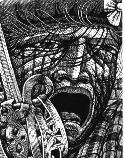
| Culloden Field (Bloody Charlie) | Bliadhna nan Caorach |
| The Year of the Burnings | Emigration Song |
In 1745, Charles Edward Stuart, "the young pretender", landed in Scotland with the intention of raising support for his plans to put the house of Stuart back on the British throne.
After a promising start, in which his Highland rebel troops, known as Jacobites, took Edinburgh and even arrived as far South as Derby, his army retreated back North of the Border. The Prince, known to his troops as "The Italian", had been raised in the old aristocratic school of warfare. He made little use of his highlander's abilities to mount guerilla raids, but instead did the gentlemanly thing and negotiated a battle with his Government opponents.
Claymores against Cannon
On April 16th 1746, seven thousand poorly armed highlanders were led to a field outside Inverness and ordered to stand facing nine thousand heavily armed British Redcoats (with many Scots among them loyal to the Government). The young prince was hesitant about what to do next, the Government forces opened fire with cannon. Well within range, the highlanders stood for nearly an hour awaiting their Prince's order to attack. By the time it came, a third of the army had already been slaughtered. There must have been very few highlanders who survived Culloden who would have shared the romantic view of "Bonnie Prince Charlie" that survived into folklore and legend.
The slaughter at Culloden had consequences few could have foreseen.
The triumphant Government used the Jacobite rising as an excuse to try and
destroy the clan system. They forbid highlanders to carry arms, or
to wear the tartan and they successfully used divide and rule tactics to
turn clansman against clansman.
In the years after Culloden, the English had been fostering a sense among the lairds of Scotland that they had more in common with their aristocratic English counterparts than with the highlanders over whom they ruled. This encouragement of class consciousness happened to co-incide with the beginnings of the industrial revolution in England.
Mill machinery in English mills was getting ever more hungry for supplied of wool. Small scale experiments on some Highland estates had proved it both possible and profitable to raise sheep in the area. The only problem was that the Highlands were not the desolate, empty sheep pastures which they are today, but were rather home to an estimated one million tenant farmers known as crofters. The disarmed and disempowered Highlanders were soon shocked to find that their Lairds were refusing to renew contracts with their tenants; so forcing crofting families off land they had lived on for countless generations.
Some Highlanders organized what we would call today passive resistance. They simply rounded up the sheep and herded them South to the Lowlands were they abandoned them. The Lairds soon sought English help to stop this attack on their bleating gold mine and the result was yet more Highlanders transported or forced into exile.
As sheep became more profitable and the crofters more troublesome, the Lairds decided enough was enough. A systematic clearing of the Highlands began which rivalled any of the so called ethnic cleansing efforts of the Ex-Yugoslav federation.
Highlanders were driven from their ancient homelands and to ensure that they could never return the roof timbers of their houses were burned. In an area with few trees this act of organized vandalism was enough to ensure the finality of the forced expatriation.
In all, hundreds of thousands of highlanders were forced from their lands. Initially, many tried to eke out an existence on the shores of the Atlantic, but it was not long before the tide of emigration started to swell. Seeking new lives in Canada and The United States, thousands upon thousands sold whatever they had to pay for passage. But for many, the dream of recreating their old lifestyle in a new land was brutally shattered by the reality of land ownership in the new world.
Now millions of people in the Americas and in Australasia can trace
their roots back to Scotland and the ethnic cleansing that proved once
again that to those in power profit will always be more important than
people.